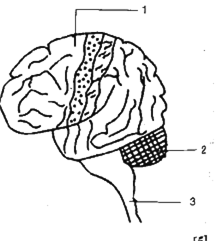 Long Answer Type
Long Answer TypeThe diagram given alongside is the external view of the human brain. Study the same and answer the questions that follow:
(i) Name the parts labelled 1,2 and 3.
(ii) State the main functions of the parts labelled 1 and 2.
(iii) How are the brain cells arranged in the part labelled ‘1’?
(iv) What is the structural and functional unit of the nervous system?
(v) Name the fluid that surrounds the brain. State its function.(i)
(1) Cerebrum,
(2) Cerebellum,
(3) Medulla oblongata.
(ii)
Part 1 (Cerebrum): Associated with memory, intelligence and sensation.
Part 2 (Cerebellum): Associated with voluntary muscular movements and maintenance of equilibrium. ‘
(iii) The inner region of the cerebrum has white matter, which is composed of the axons of neurons. The outer region of the cerebrum has grey matter, which is composed of the perikaryon (cytons) of neurons.
(iv) Neuron is the structural and functional unit of the nervous system.
(v) Cerebrospinal fluid is the fluid that surrounds the brain.
Functions :
(1) It protects CNS against mechanical shock and injury.
(2) It maintains a constant pressure inside the cranium.
Explain briefly .
(i) There is an increasing dependence today on natural sources of energy like sunlight and wind.
(ii) The breathing rate increases after vigorous exercise.
(iii) On entering a poorly lit room, one feels blinded for a short while.
(iv) Glucose is normally not found in urine.
(v) Xerophytes have their leaves modified to spines or reduced in size.